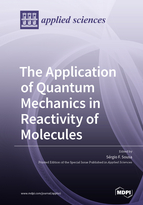The Application of Quantum Mechanics in Reactivity of Molecules
A special issue of Applied Sciences (ISSN 2076-3417). This special issue belongs to the section "Quantum Science and Technology".
Deadline for manuscript submissions: closed (30 June 2020) | Viewed by 28608
Special Issue Editor
Interests: computational enzymatic catalysis; QM/MM; docking; virtual screening; molecular dynamics simulations
Special Issues, Collections and Topics in MDPI journals
Special Issue Information
Over the last decades, the increase in computational resources, coupled with the popularity of competitive quantum mechanics alternatives (particularly DFT), has promoted the widespread penetration of quantum mechanics calculations into a variety of fields targeting the reactivity of molecules.
The present Special Issue aims to explore this diversity of application of quantum mechanics—including ab inition, semi-empirical, DFT, and pos-Hartree Fock methods—in the study of the electronic structure of molecules and their reactivity.
This Special Issue invites researchers to submit original research papers and review articles related to any chemical problem to which quantum mechanics has been applied. The topics of interest include, but are not limited to:
- Development and Application of QM Methods
- QM Studies on Catalysis
- QM Studies on Magnetic Systems
- QM Studies on Excited States
- QM Studies on Transition Metal Chemistry
- QM Studies on Organic Chemistry
- QM and QM/MM Studies Applied Biological Systems
- Quantum Dynamics
- New or Improved Quantum Mechanical Methods
- Software Programs featuring QM codes
Dr. Sérgio Filipe Sousa
Guest Editor
Manuscript Submission Information
Manuscripts should be submitted online at www.mdpi.com by registering and logging in to this website. Once you are registered, click here to go to the submission form. Manuscripts can be submitted until the deadline. All submissions that pass pre-check are peer-reviewed. Accepted papers will be published continuously in the journal (as soon as accepted) and will be listed together on the special issue website. Research articles, review articles as well as short communications are invited. For planned papers, a title and short abstract (about 100 words) can be sent to the Editorial Office for announcement on this website.
Submitted manuscripts should not have been published previously, nor be under consideration for publication elsewhere (except conference proceedings papers). All manuscripts are thoroughly refereed through a single-blind peer-review process. A guide for authors and other relevant information for submission of manuscripts is available on the Instructions for Authors page. Applied Sciences is an international peer-reviewed open access semimonthly journal published by MDPI.
Please visit the Instructions for Authors page before submitting a manuscript. The Article Processing Charge (APC) for publication in this open access journal is 2400 CHF (Swiss Francs). Submitted papers should be well formatted and use good English. Authors may use MDPI's English editing service prior to publication or during author revisions.
Keywords
- Density Functional Theory
- Ab Initio
- Semi-Empirical Methods
- Quantum Dynamics
- QM/MM
- Quantum Dynamics






